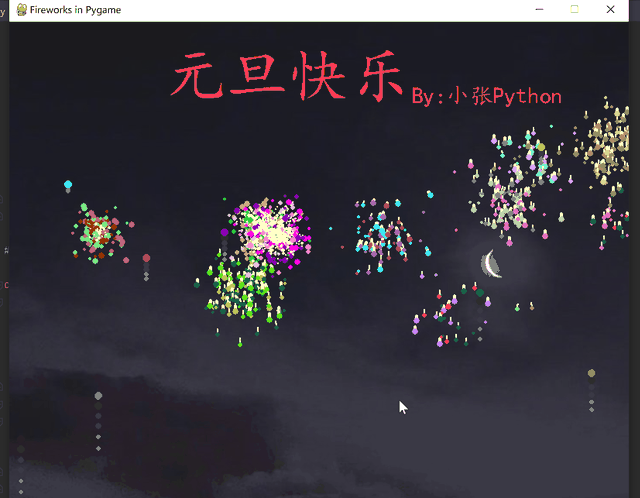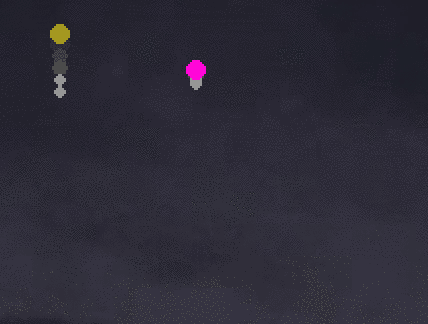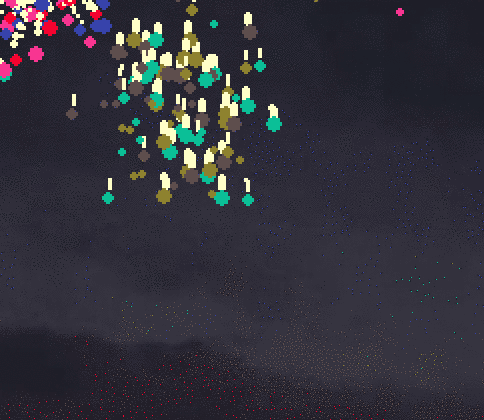Python教程
逢年过节就拿出这些代码,Python 制作一个炫酷烟花秀
今天是2021 的最后一天,到了这个时间点,部分小伙伴已经开始复盘这一年的得与失。比如今年增加了多少技能点,看了多少本书,写了多少篇文章或者年前的小目标实现进度大概多少等等;做一个象征性的年终总结来告别2021,迎接2022:
本篇文章,带大家用 Python 制作一个炫酷烟花秀,来迎接即将到来的元旦佳节。开始之前先看一下最终效果

环境介绍:
语言:Python;
库:Pygame;
原理介绍
很多人学习蟒蛇,不知道从何学起。 很多人学习python,掌握了基本语法之后,不知道在哪里寻找案例上手。 很多已经做了案例的人,却不知道如何去学习更多高深的知识。 那么针对这三类人,我给大家提供一个好的学习平台,免费获取视频教程,电子书,以及课程的源代码! QQ群:101677771
在介绍代码之前,先介绍下 Pygame 绘制烟花的基本原理,烟花从发射到绽放一共分为三个阶段:
1, 发射阶段 :在这一阶段烟花的形状是线性向上,通过设定一组大小不同、颜色不同的点来模拟“向上发射” 的运动运动,运动过程中 5个点被赋予不同大小的加速度,随着时间推移,后面的点会赶上前面的点,最终所有点会汇聚在一起,处于 绽放准备阶段 ;

2, 烟花绽放 :烟花绽放这个阶段,是由一个点分散多个点向不同方向发散,并且每个点的移动轨迹可需要被记录,目的是为了追踪整个绽放轨迹。

3, 烟花凋零 ,此阶段负责描绘绽放后烟花的效果,绽放后的烟花,而在每一时刻点的下降速度和亮度(代码中也叫透明度)是不一样的,因此在代码里,将烟花绽放后将每个点赋予两个属性:分别为重力向量和生命周期,来模拟烟花在不同时期时不同的展现效果,

代码实操
代码部分将烟花封装为三个类:
Firework : 烟花整体;
Particle : 烟花粒子(包含轨迹)
Trail : 烟花轨迹,本质上是一个点 。
三个类之间的关系为:一个Firework 由多个 Particle 构成,而一个 Particle 由多个 Trail 构成
首先设置全局变量,例如重力向量,窗口大小,Trail 的颜色列表(多为灰色或白色)以及不同状态下 Trail 之间间隔
gravity = vector(0, 0.3) DISPLAY_WIDTH = DISPLAY_HEIGHT = 800 trail_colours = [(45, 45, 45), (60, 60, 60), (75, 75, 75), (125, 125, 125), (150, 150, 150)] dynamic_offset = 1 static_offset = 3
创建 Trail 类,定义 show 方法绘制轨迹 、get_pos 实时获取轨迹坐标
class Trail:
def __init__(self, n, size, dynamic):
self.pos_in_line = n
self.pos = vector(-10, -10)
self.dynamic = dynamic
if self.dynamic:
self.colour = trail_colours[n]
self.size = int(size - n / 2)
else:
self.colour = (255, 255, 200)
self.size = size - 2
if self.size < 0:
self.size = 0
def get_pos(self, x, y):
self.pos = vector(x, y)
def show(self, win):
pygame.draw.circle(win, self.colour, (int(self.pos.x), int(self.pos.y)), self.size)
Particle 类核心代码
class Particle:
def __init__(self, x, y, firework, colour):
self.firework = firework
self.pos = vector(x, y)
self.origin = vector(x, y)
self.radius = 20
self.remove = False
self.explosion_radius = randint(5, 18)
self.life = 0
self.acc = vector(0, 0)
# trail variables
self.trails = [] # stores the particles trail objects
self.prev_posx = [-10] * 10 # stores the 10 last positions
self.prev_posy = [-10] * 10 # stores the 10 last positions
if self.firework:
self.vel = vector(0, -randint(17, 20))
self.size = 5
self.colour = colour
for i in range(5):
self.trails.append(Trail(i, self.size, True))
else:
self.vel = vector(uniform(-1, 1), uniform(-1, 1))
self.vel.x *= randint(7, self.explosion_radius + 2)
self.vel.y *= randint(7, self.explosion_radius + 2)
# 向量
self.size = randint(2, 4)
self.colour = choice(colour)
# 5 个 tails总计
for i in range(5):
self.trails.append(Trail(i, self.size, False))
def apply_force(self, force):
self.acc += force
def move(self):
if not self.firework:
self.vel.x *= 0.8
self.vel.y *= 0.8
self.vel += self.acc
self.pos += self.vel
self.acc *= 0
if self.life == 0 and not self.firework: # check if particle is outside explosion radius
distance = math.sqrt((self.pos.x - self.origin.x) ** 2 + (self.pos.y - self.origin.y) ** 2)
if distance > self.explosion_radius:
self.remove = True
self.decay()
self.trail_update()
self.life += 1
def show(self, win):
pygame.draw.circle(win, (self.colour[0], self.colour[1], self.colour[2], 0), (int(self.pos.x), int(self.pos.y)),
self.size)
def decay(self): # random decay of the particles
if 50 > self.life > 10: # early stage their is a small chance of decay
ran = randint(0, 30)
if ran == 0:
self.remove = True
elif self.life > 50:
ran = randint(0, 5)
if ran == 0:
self.remove = True
Firework 类核心代码
class Firework:
def __init__(self):
# 随机颜色
self.colour = (randint(0, 255), randint(0, 255), randint(0, 255))
self.colours = (
(randint(0, 255), randint(0, 255), randint(0, 255)),
(randint(0, 255), randint(0, 255), randint(0, 255)),
(randint(0, 255), randint(0, 255), randint(0, 255)))
self.firework = Particle(randint(0, DISPLAY_WIDTH), DISPLAY_HEIGHT, True,
self.colour) # Creates the firework particle
self.exploded = False
self.particles = []
self.min_max_particles = vector(100, 225)
def update(self, win): # called every frame
if not self.exploded:
self.firework.apply_force(gravity)
self.firework.move()
for tf in self.firework.trails:
tf.show(win)
self.show(win)
if self.firework.vel.y >= 0:
self.exploded = True
self.explode()
else:
for particle in self.particles:
particle.apply_force(vector(gravity.x + uniform(-1, 1) / 20, gravity.y / 2 + (randint(1, 8) / 100)))
particle.move()
for t in particle.trails:
t.show(win)
particle.show(win)
def remove(self):
if self.exploded:
for p in self.particles:
if p.remove is True:
self.particles.remove(p)
if len(self.particles) == 0:
return True
else:
return False
最后,写一个 main 方法来对 pygame 环境进行初始化,例如背景图片,文字,设置页面刷新间隔,程序中设置的每 60ms 刷新一次。
pygame.display.set_caption("Fireworks in Pygame") # 标题
background = pygame.image.load("img/1.png") # 背景
myfont = pygame.font.Font("img/simkai.ttf",80)
myfont1 = pygame.font.Font("img/simkai.ttf", 30)
testsurface = myfont.render("元旦快乐",False,(255,255,255))
testsurface1 = myfont1.render("By:小张Python", False, (255, 255, 255))
# pygame.image.load("")
win = pygame.display.set_mode((DISPLAY_WIDTH, DISPLAY_HEIGHT))
# win.blit(background)
clock = pygame.time.Clock()
fireworks = [Firework() for i in range(2)] # create the first fireworks
running = True
while running:
clock.tick(60)
win.fill((20, 20, 30)) # draw background
win.blit(background,(0,0))
win.blit(testsurface,(200,200))
win.blit(testsurface1, (300,200))
if randint(0, 20) == 1: # create new firework
fireworks.append(Firework())
update(win, fireworks)
另外程序中会对你的按键命令进行监控:
- 当按下键 1时 ,会立即生成一个新的 “烟花”;
- 当按下键 2时,会同时生成 10 个 “烟花”
for event in pygame.event.get():
if event.type == pygame.QUIT:
running = False
if event.type == pygame.KEYDOWN: # Change game speed with number keys
if event.key == pygame.K_1: # 按下 1
fireworks.append(Firework())
if event.key == pygame.K_2: # 按下 2 加入10个烟花
for i in range(10):
fireworks.append(Firework())
总的来说,整个小案例的代码量不算很多,一共250行左右,但案例中涉及到较为复杂的绘制逻辑和抽象的类之间的封装关系,因此大家理解代码相对会需要耗费点时间。
写到这里,本篇文章算基本结束了,主要介绍就是如何用 Pygame 来模拟一个烟花绽放过程,核心内容大致两点:第一,如何用绘制点的方式来模拟烟花绽放运动轨迹;第二 介绍Pygame 一些基础用法:替换背景,绘制文字,更新状态等功能;
-
用FastAPI掌握Python异步IO:轻松实现高并发网络请求处理01-03
-
封装学习:Python面向对象编程基础教程01-02
-
Python编程基础教程12-28
-
Python编程入门指南12-27
-
Python编程基础12-27
-
Python编程基础教程12-27
-
Python编程基础指南12-27
-
Python编程入门指南12-24
-
Python编程基础入门12-24
-
Python编程基础:变量与数据类型12-24
-
使用python部署一个usdt合约,部署自己的usdt稳定币12-23
-
Python编程入门指南12-20
-
Python编程基础与进阶12-20
-
Python基础编程教程12-19
-
python 文件的后缀名是什么 怎么运行一个python文件?-icode9专业技术文章分享12-19

